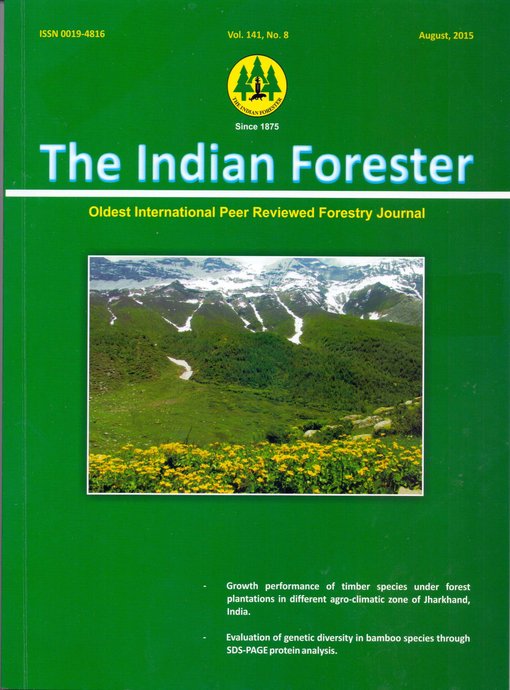Diversity and Foraging Behaviour of Different Insect Pollinators on Sunflower, Helianthus annuus Lin
DOI:
https://doi.org/10.36808/if/2015/v141i8/77012Keywords:
Helianthus annuus, Diversity, Insect Pollinators, Foraging Behavior.Abstract
Present investigation was carried out to assess diversity and foraging behaviour of different insect pollinators visiting on sunflower, Helianthus annuus Lin. Fourteen insect species belonging to five families and two orders Hymenoptera and Diptera were observed visiting the blossom of sunflower. The activity of flower visiting insects was recorded o highest (3.80 foragers/head/5min) at 1200 h when average temperature and relative humidity were 39.2 °C and 40.1 per cent respectively. Among the insect visitors, average relative abundance was observed highest with Apis mellifera (4.50 foragers/head/5min; 28.57% of total pollinators). The overall mean of foraging rate and mean foraging speed of pollinators was observed highest (10.13 flower head/foragers/min and 6.43 sec/flower, respectively) at 1000 h when o average temperature and relative humidity were 36.9°C and 49.6 per cent. Amongst the foragers, foraging rate was highest of Apis mellifera (10.83 flowers head/foragers/min); constituting 25.63 per cent of the total pollinators observed and the average time spent by single forager per flower was maximum with Apis mellifera 6.90 sec/flower.References
Abrol D.P. and Kapil R.P. (1996). Insect pollinators of some oilseed crops. Journal of Insect Science, 9 (2):172–174.
Nabhan G.P. and Buchmann S. (1997) in Nature's Services: Societal Dependence on Natural Ecosystems, ed. Daily, G. C. (Island, Washington, DC): 133–150.
Damodaran T. (2007). Sunflower Research in India: Info Metric Study based on CABI Crop Science Database. ISOR, National seminar, 29-31 Jan, 2007. : 407-408.
FAO (1995). Pollination of cultivated plants in the tropics. Agric. Serv. Bull., No. 118, p.198.
FAO (2005). Protecting the pollinators.www.fao.org/ag/magazine/0512sp1.htm assessed on 21.05.2014.
Free J.B. (1970). Insect pollination of crops. Academic Press, London-New York.
Free J.B. (1993). Insect pollination of crops. 2nd Edition, Acad. Press, London-New York. : 172-180.
Free J.B. (1999). Pollination in the tropics. Beekeeping & Development, 50: 10-11; 51: 6-7; 53: 4-5.
Nderitu J., Nyamasyo G., Kasina M. and Oronje M.L. (2008). Diversity of sunflower pollinators and their effect on seed yield in Makueni District, Eastern Kenya. Spanish Journal of Agricultural Research, 6 (2): 271-278
Kasina M., Nderitu J., Nyamasyo G. and Oronje M.L. (2007). Sunflower pollinators in Kenya: Does diversity influence seed yield? African Crop Science Conference Proceedings. 8:1149-1153.
McGregor S.E. (1976). Insect pollination of cultivated crop plants. USDA/ARS Agriculture Handbook 496, Washington, USA. 411 pp.
Panchabhavi K.S. and Rao K.J. (1978). Note on the effect of mixed cropping of niger on the activities of insect pollinators and seed filling of sunflower in Karnataka. Indian Journal of Agricultural Science, 48 (4): 254-255.
Pande P., Panda B. and Sontake B.K. (1991). Foraging behaviour of honey bees on sunflower (Helianthus annus L.) sown on different dates. Indian Bee Journal, 53 (1-4): 44-49.
Swaminathan R. and Bhardwaj S.C. (1982). Bee pollinators of sunflower and their foraging behaviour. Indian Bee Journal, 44(2): 32-34.
Tependino V.J. (1979).The importance of bees and other insect pollinators in maintaining floral species composition. Great Basin Naturalist Memoirs,3: 139-150.
Venkattakumar R., Ramanujaneyulu G.V., Padmaiah M. and Rao R.R., (2007). Impact of sunflower demonstrations- an evaluative study. ISOR, National Seminar, 29-31 Jan, 2007.pp 413-414.
Downloads
Downloads
Published
How to Cite
Issue
Section
License
Unless otherwise stated, copyright or similar rights in all materials presented on the site, including graphical images, are owned by Indian Forester.





